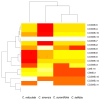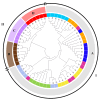Molecular Characterization of Citrus Accessions Grown for Pre-Breeding Purposes
- PMID: 40864810
- PMCID: PMC12384419
- DOI: 10.3390/cimb47080656
Molecular Characterization of Citrus Accessions Grown for Pre-Breeding Purposes
Abstract
The objective of this work was to analyse the genetic diversity of a population of Citrus spp. in the south of the State of Espírito Santo, Brazil, for pre-breeding studies. For that, a total of sixty genotypes were analysed, including ten citrus varieties from four species of the Citrus genus. The methodology involved DNA extraction, amplification via polymerase chain reaction, and the use of a set of 16 Simple Sequence Repeat markers. These markers identified 42 alleles, with a variation of one to four alleles per locus, an average heterozygosity value of 0.53, and an average polymorphic information content of up to 0.29 per species. After the analysis, a dissimilarity matrix was generated using Jaccard distance and a dendrogram, revealing the formation of two groups: Group I, comprising Citrus sinensis varieties, and Group II, comprising varieties of Citrus latifolia, Citrus aurantifolia, and Citrus reticulata. Our study demonstrated that the combination of these markers allowed for the differentiation of genotypes within the collection. The results obtained are valuable for the future management of the collection and the efficient use of genetic diversity estimation in Citrus spp.
Keywords: Citrus spp.; SSR marker; citrus germplasm; genetic variability.
Conflict of interest statement
The authors declare no conflicts of interest.
Figures



References
-
- Viuda-Martos M., Ruiz-Navajas Y., Fernandes-Lopes J., Perez-Alvarez J.A. Atividade antifúngica dos óleos essenciais de limão (Citrus Lemon L.), tangerina (Citrus reticulata L.), toranja (Citrus paradisi L.) e laranja (Citrus sinensis L.) Controle Aliment. 2008;19:1130–1138. doi: 10.1016/j.foodcont.2007.12.003. - DOI
-
- Luro F., Paoli M., Costantino G., Marchi E. Investigation of Diversity by Analyzing the Polymorphism of SSR Markers and the Composition of Leaf and Fruit Essential Oils of 72 Mandarins (Citrus reticulata Blanco) Horticulturae. 2023;9:577. doi: 10.3390/horticulturae9050577. - DOI
-
- Vilas Boas V.P.P., Belico L.A., Lima J.P., Vilas Boas E.V.B. Potencial Sensorial, Nutricional e Funcional de Diferentes Tipos de Citros; Proceedings of the I Congresso Luso-Brasileiro de Horticultura; Lisbon, Portugal. 1–4 November 2017; pp. 231–237.
LinkOut - more resources
Full Text Sources
Miscellaneous

